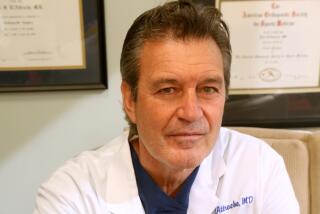Ankle transplant surgery gave former baseball star Robin Ventura a new lease on life
- Share via
From Arroyo Grande, Calif. — Only months after wrapping up a 16-year major league career, Robin Ventura could barely walk without a cane.
So intense was the discomfort in his right ankle, mangled in a slide earlier and deadened with painkillers thereafter, that the former All-Star third baseman found he lingered in bed a little longer each morning, unwilling to step into the day.
“I didn’t go places for a long time,” Ventura volunteers, “because I didn’t feel like getting up and walking.”
Drastic measures, he says, were seriously considered.
As Ventura remembers it, “I told my wife, ‘I am at the point where if I have to cut it off, I’ll cut it off,’ because it hurt that bad. ‘Take it right below the knee. I don’t care.’”
Luckily for Ventura, who played his last 1½ seasons with the Dodgers, it never got to that point because he found in William Bugbee of San Diego an orthopedic surgeon who offered an uncommon solution: ankle transplant surgery.
That was in 2005.
Six years later, an ankle joint harvested from a cadaver screwed into his right ankle, a smiling Ventura walks without a limp into a coffee shop near his home in Arroyo Grande.
“Now I can play golf, I can walk, I can go hiking,” the father of four says. “I just can’t run. I mean, if somebody’s chasing me with a gun or a knife or something, I can run. But if I run, it will hurt the next day. Anything else is pretty much fair game.”
This is the ambulatory retirement that Ventura, 43, envisioned.
His had a noteworthy career, especially considering that he went undrafted as an All-Southern Section shortstop at Santa Maria Righetti High and attracted only one scholarship offer.
Switching to third base, he was a three-time All-American at Oklahoma State. As a sophomore, he set a still-standing major college record by hitting safely in 58 consecutive games. (It took two future major league pitchers, Stanford teammates Jack McDowell and Al Osuna, to end the historic streak.)
Then-Oklahoma State coach Gary Ward, suggesting that Ventura was a quick study, later told Baseball America magazine, “It was like being a tennis coach for Martina Navratilova.”
Taken by the Chicago White Sox with the 10th pick in the 1988 amateur draft, Ventura was a two-time All-Star and six-time Gold Glove winner after snagging a gold medal with Team USA at the Seoul Olympics. He played with four major league teams, batting .267 with 294 home runs and 1,182 runs batted in.
Thanks to comical video evidence that won’t die, however, he’s probably best remembered for taking offense to being hit by a pitch from Hall of Famer Nolan Ryan in August 1993.
Charging the mound, Ventura wound up ensnared in a headlock by the Texas Rangers right-hander, tattooed by a half-dozen Ryan-inflicted “noogies” and touching off a benches-clearing brawl.
As former major league manager Mike Hargrove later noted, “Going after Nolan is like going after the Lincoln Memorial.”
What was Ventura thinking?
“We’d had a lot of going back and forth that season,” he says of the White Sox and Rangers. “Guys were getting hit, and it was just one of those things where something was going to happen eventually. And the game kind of picked me. . . .
“Personality-wise,” he adds, charging Ryan “wasn’t going to be my first thought, but sometimes you’re just in one of those moments with a team . . . and that’s what you’re supposed to do.”
While joking that “the Internet keeps me alive,” Ventura denies reports that he and Ryan later became friends.
“I’ve never met him,” he says.
Though Ventura badly injured his ankle during a spring training exhibition in 1997, he enjoyed one of his most productive seasons two years later, batting a career-high .301 with 32 home runs and a career-high 120 RBIs for the New York Mets.
By the time he was traded from the New York Yankees to the Dodgers in 2003, however, he was mostly a role player.
Two years later, he was virtually immobile without a cane.
“People with post-traumatic arthritis are miserable,” notes Bugbee, his doctor. “You don’t realize it until you live with it . . . but it’s very debilitating. Simple things become very difficult.”
Bugbee performs about 10 ankle allografts a year, removing a rectangular-shaped section of bone and cartilage and replacing it with a harvested joint shaped to fit the space.
“This operation is designed to relieve pain and allow people to have a normal quality of life with activities of everyday life,” Bugbee says. “The fact that they can go from having pain every minute on their feet to being able to take their kids to school and walk their dog — that’s a pretty good improvement.”
Ventura calls it a life-changer.
No longer requiring chauffeur service from wife Stephanie, as he did before surgery, he is a volunteer assistant baseball coach at Arroyo Grande High. This week, he’s in Omaha working as an ESPN analyst at the College World Series.
And he’s pain-free.
“I’m grateful,” he says.
More to Read
Go beyond the scoreboard
Get the latest on L.A.'s teams in the daily Sports Report newsletter.
You may occasionally receive promotional content from the Los Angeles Times.










